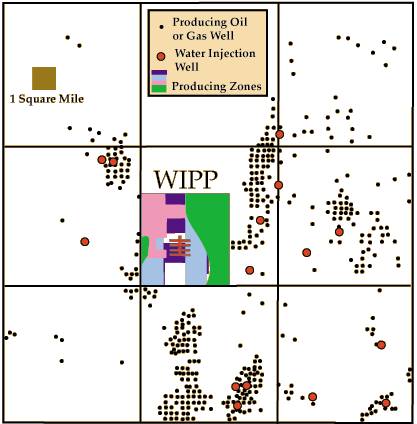
Scout Haven
Out in the "oil patch" speculators and oil companies hire "scouts" to keep them informed about the success or failure of other operators. A scout may sit in a car or in a blind, peering through binoculars, measuring the depth of the hole by counting the number of pipe sections pulled up in the drill string. They may check the drilling rate by watching the descent of the swivel or they may listen for a change the pitch of the diesel engine to learn if the bit has entered a particular geologic formation. A break in the drilling routine or the arrival of a logging crew or a mud truck may tell a scout that it's a dry hole or that the bit has reached the "pay," the producing horizon. Investment money is at stake and all the parties involved try to keep up. The New Mexico Institute of Mining and Technology in Socorro keeps records of well logs and drill cuttings from many oil and gas wells drilled in New Mexico and assigns geologists to keep abreast of petroleum development, a source of tax revenue.
I recall, in 1975 or 1976, a study by an economic geologists at NM Tech on the potential for petroleum production for the section of land staked out by the AEC for the WIPP site. The State of New Mexico wanted to know the value of the land and the resources it might be giving up at WIPP. The Tech geologist studied the stratigraphy and the history of production in the area and plotted the location of producing wells and dry holes in the region and concluded that the WIPP site lay at the intersection of two producing trends. He concluded that the place chosen for WIPP was a good prospect for future oil and gas production.
This was not good news for WIPP because one of the firm criteria for siting a nuclear waste repository was avoiding conflict with natural resources. Resources were valuable, for one thing, but most important, exploration or exploitation of resources such as potash or petroleum might lead to a breach and release of waste. After the report by the Tech geologist was released, the government contractor for site exploration (Sandia Labs) hired two petroleum consultants from Texas to repeat the Tech study. Both consultants concluded that the WIPP site was a poor oil and gas prospect. With two new reports in hand the weight of evidence was then two to one in favor of little or no conflict with petroleum and the WIPP project had a green light. It wasn't long, however, before oil derricks began sprouting up around the WIPP site.

If you study the map you'll see the trends and today about 400 derricks and producing oil and gas wells are in the 9 sections around WIPP. The State geologist had it right. WIPP is near the bullseye of a major petroleum find and one wonders if scouts were watching the WIPP proceedings through their binoculars. At least one well is slant drilled under the withdrawal area and pools of oil and reservoirs of gas projected below the repository invite future drilling into the pressurized brine reservoir under its rooms and tunnels (see Praedial Universe). DOE science managers, in their evaluation of petroleum resources, managed to produce a "best case" estimate. The diversion bought time and took the project through the construction phase and the point of no return.
PREVIOUS PAGE............NEXT PAGE